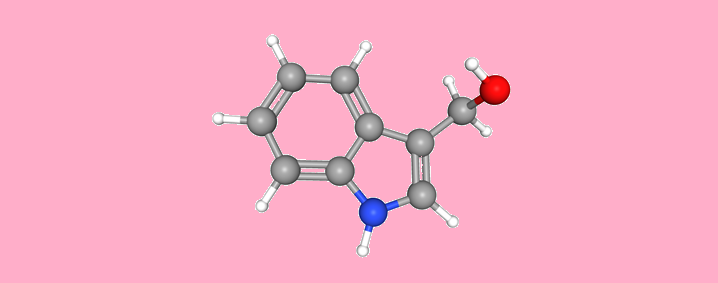INTRODUCTION
Indole-3-carbinol is a colorless powder with a characteristic odor.
The product finds uses in various fields by virtue of the indole ring, which is active and mainly imparts medicinal properties to the molecule. It is also an important dietary supplement.
Manufacture
Biologically, it is produced by enzyme-catalysed hydrolysis of glucosinolate, abundantly found in cabbage, cauliflower, and other vegetables of Bressica family.
Synthetically and commercially, it is product of indole-3-acetic acid reduction.
| Synonyms | Indole-3-methanol |
| CAS no. | 700-06-1 |
| EINECS no. | 211-836-2 |
| Molecular formula | C9H9NO |
| Molecular weight | 147.17 |
| Structure |  |
Medicinal Uses
Indiole-3-carbinol is cited to have medicinal properties and is subject of many clinical trials. It is applied in medicines to:
| prevent breast cancer |
| cure obesity |
| lower risk of prostate cancer recurrence |
Nutritional Uses
| As an antioxidant |
| Dietary supplement |
Value-added Intermediates
Indole-3-carbinol is used as a KRM to make various intermediates for pharmaceutical applications, such as:
| Indole-3-carboxylic acid |
| Indole-3-carboxaldehyde |
| Indolo[3,2b]carbazole |
| 3,3’-Diindolylmethane |
SPECIFICATIONS
| Test | Unit | Specification |
|---|---|---|
| Appearance | – | Off-white to red powder |
| Identification | – | Should give positive reaction |
| Melting range | °C | 97-100 |
| Loss on drying | % | Max 2.0 |
| Residue on ignition | % | Max 0.1 |
| Residual solvents | – | Not detected |
| Assay by HPLC | % | Min 99.0 |
| Total heavy metals | ppm | Max 10.0 |
| Lead | ppm | Max 0.5 |
| Arsenic | ppm | Max 0.5 |
| Mercury | ppm | Max 0.1 |
| Cadmium | ppm | Max 0.5 |
| Particle size | ||
| 40 mesh | % | 100 |
| 80 mesh | % | 80 |
| 120 mesh | % | 60 |
| Microbial Test | ||
| Total plate count | cfu/g | Max 1000 |
| Yeast and mold | cfu/g | Max 100 |
| Salmonella | – | Should be absent |
| E Coli | – | Should be absent |
| Staphylococcus | – | Should be absent |
| Pseudomonas | – | Should be absent |
CERTIFICATION
The product is offered from NSF-GMP facility supported by a DMF for Nutraceutical application.
STORAGE
Recommended storage temperature is 2° to 8°C
PACKING
10 kg bag in HDPE Drum
ExSyn offers indole-3-carbinol on commercial scale and welcomes enquiries. No matter the quantity you need, our exceptional quality and service will make ExSyn your supplier of choice! If you need any additional information or SDS, please get in touch with us.
5-Methyl-3-vinyl-2-oxazolidinone (V-MOX) is a highly reactive monomer valued for its low viscosity, mild odor, and excellent reactivity. It is widely used as a reactive diluent in UV-curable inks and coatings, where it enhances adhesion, produces brighter colors, and improves safety compared to conventional diluents. In addition, V-MOX serves as a key building block in the synthesis of kinetic hydrate inhibitor (KHI) polymers, which are applied in oil and gas production to prevent hydrate blockages in pipelines.
Zinc ricinoleate is the zinc salt of ricinoleic acid, a hydroxylated fatty acid derived mainly from castor oil (Ricinus communis). It appears as a white to slightly yellowish powder, waxy solid, or paste, depending on formulation. Its most valuable property is its ability to trap and absorb odor molecules such as amines, sulfides, and short-chain fatty acids, making it an essential ingredient in deodorant and odor-control products.
2-(tert-Butyl amino)ethyl methacrylate (TBAEMA) is a functional methacrylate monomer that contains a secondary amine group and a hydrophobic tert-butyl moiety, giving it excellent versatility in pH-responsive and adhesion-enhancing polymer systems.
It is valued in printing ink formulations for its ability to enhance adhesion, flexibility, and surface interaction.
Commonly known as potassium bis(fluorosulfonyl)imide (KFSI), the compound has a three-carbon backbone bearing six fluorine atoms and two sulfonimide (-SO₂F) groups. The molecule’s architecture lends it both high chemical stability and useful reactivity. Because of its excellent ionic conductivity and thermal / electrochemical stability, it finds use in advanced electrolyte formulations—for example in lithium-ion and next-generation batteries, in ionic liquids, and in other electrochemical systems.
Colchicine is a naturally occurring alkaloid obtained primarily from the autumn crocus (Colchicum autumnale) and related species. It has been used in medicine for centuries, especially for the treatment of gout and Familial Mediterranean Fever. In modern medicine, Colchicine is valued also in conditions like pericarditis, Behçet’s disease, and certain dermatological and cardiac disorders.
1-Butylimidazole is a versatile organic heterocyclic compound belonging to the imidazole family, where a butyl group (–CH₂–CH₂–CH₂–CH₃) is attached to the nitrogen atom at the 1-position of the imidazole ring. Its applications span organic synthesis, materials science, and bioactive compound development due to its tunable physicochemical properties and structural versatility.
Atropine sulfate monohydrate is a chemical compound, specifically a salt of atropine and sulfuric acid, with one water molecule (monohydrate) attached. It is commonly used as a medication and in research due to its anticholinergic properties, meaning it blocks the effects of acetylcholine at muscarinic receptors.
4-Aminobenzoic acid, commonly abbreviated as PABA, is an aromatic amine and carboxylic acid compound. It consists of a benzene ring substituted with an amino group (–NH₂) in the para position to a carboxylic acid group (–COOH).
2-Amino-5-Nitrophenol (5-NAP) is an organic compound with the molecular formula C₆H₆N₂O₃. It is a substituted phenol with both an amino group (-NH₂) and a nitro group (-NO₂) attached to a benzene ring, along with a hydroxyl group (-OH).
